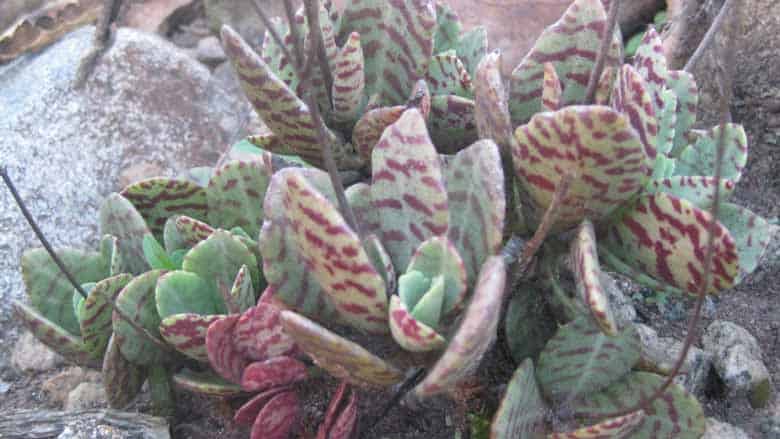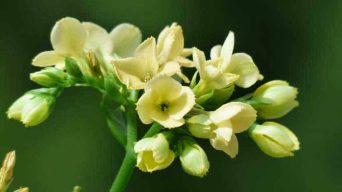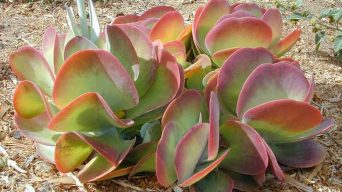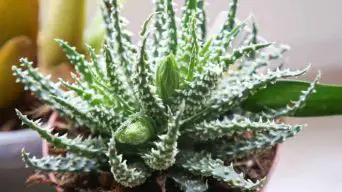The Kalanchoe Humilis succulent plant is a beautiful and easy to care for houseplant. It does best in bright, indirect light.
If you live somewhere where the weather is constantly warm, this plant will do well outside as long as it has protection from the wind and sun.
In colder climates, they can be taken inside during the winter months or grown under lights indoors.
This article will discuss how to propagate and care for your Kalanchoe plant so it thrives!
About the Kalanchoe Humilis ‘Desert Surprise’
The Kalanchoe Humilis succulent plant is a member of the Crassulaceae family, which contains over 400 species.
It is a flowering plant that can grow up to three feet tall. It is also a bulb plant with an elongated and often stemless body.
The leaves are small, triangular-shaped, lustrous green in color, and can grow up to three inches long and one inch wide at the petiole or leaf stalk base.
The Kalanchoe Humilis, also known as the Desert Surprise, originates from Madagascar and is grown as a houseplant for its attractive flowers.
It will bloom most frequently during the fall months when it produces clusters of light pink bell-shaped blossoms with yellowish centers on top of each flower head.
The blooming period usually lasts about two to four weeks. There may be more than 50 individual flowers per cluster, depending upon how well it was cared for over time.
Kalanchoe Humilis is a succulent plant that makes an excellent indoor and outdoor container garden specimen.
How To Care for Kalanchoe Humilis (Desert Surprise)
Sun Exposure & Light Requirements
Kalanchoe Humilis succulents can be grown in direct sunlight to partial shade. It needs to be placed in a location that receives bright light but not direct sun.
Plants grown with medium levels of sunlight will have more compact leaves and thicker stems than plants grown under low levels of sunlight. That means that they will produce fewer flowers.
The color range for this succulent plant also changes depending on how much sun it gets.
Kalanchoes grown with little or no exposure to sunlight develop deep green leaves, while those exposed to full sun turn into shades of reds, oranges, yellows, and pink colors.
It can grow well indoors if it gets a lot of sunlight through the windows.
Watering
Water the Kalanchoe Humilis regularly during early spring and summer. Once a week is enough if it’s in full sun. The soil should be kept moist but not wet, as this can cause root rot to set in and kill your plant. Allow the top inch or so of soil to dry out before watering again for best results.
Wet leaves at any time will lead to fungal infection, which might also end up prematurely killing off some of your plants’ stems or flowers. This includes when you are fertilizing them with fertilizer spikes (more on that later).
During winter months, lower its water intake by about one-third – meaning once every two weeks instead of once a week- since this succulent would grow slower.
The most common mistake made by Kalanchoe owners is overwatering their plants which can lead to root rot that kills your plant!
Be sure not to wet down leaves because this may cause them brown spots due to sunburn.
Wipe off excess water from leaves using a paper towel after watering your plant for it to stay healthy and happy! You want the roots of the Kalanchoe to remain moist but the leaves to dry out a bit.
Soil
Kalanchoe Humilis is a succulent plant; therefore, it needs soil that drains well but holds moisture.
Kalanchoes are native to Madagascar and typically grow on rocks in the region’s humid tropical climate, where they receive a natural buildup of humus from leaf litter below.
The best types of soil for your Kalanchoe include a cactus mix or garden loam (loosely packed). It would be best if you avoided soils with high clay content, such as heavy potting soil.
The soil should have a good drainage system and should not be too sticky.
Temperature and Humidity
The Kalanchoe Humilis prefers warm temperatures between 65-85°F.
But will grow decently in cooler weather when planted outdoors as long as they are given protection from frost and cold damage during their dormant season.
Humilis does not like to be too hot but cannot tolerate freezing temperatures. To make sure your plant has the right temperature and humidity levels, you should put it in a cool place during its dormant season.
Leave it in its pot for better drainage. It is also recommended that Kalanchoes grown indoors have an east or west window where they receive morning sun.
Avoid giving them direct afternoon sun because this can scorch leaves from overheating.
Humidity is essential for this plant because it cannot tolerate too much water. The right humidity level is 50-70%.
You can feel the humidity by touching the top of your Kalanchoe. If it is dry, you should increase the moisture in its pot and check that there are no leaks around the pot’s rim.
You can also measure the humidity by using a digital or analog hygrometer.
Fertilizing Your Kalanchoe Humilis Plant
A Kalanchoe Humilis plant will require fertilizer during its growing season, which is from April to September.
You can use a fast-acting soluble or slow-release fertilizer to fertilize your plants.
You can fertilize every two weeks when the plant is growing and one week in between when it is not growing. This should only occur if water is being applied regularly as well.
Without adequate water, the effectiveness of any type of fertilizers will decrease dramatically.
It’s important not to overfeed these plants because this will result in leaf burn. This can cause scarring on the stems of your succulent plant as well as weaken its ability to absorb water.
It’s also important to note that the Kalanchoe Humilis is sensitive to high levels of salts and fluoride.
As your plant grows, you may need more frequent watering as well as feeding if you’re in a drought or heatwave.
Potting and Repotting Kalanchoe Humilis Succulents
In general, Kalanchoes need to be repotted every two or three years. Some succulents can go much longer, but it will depend on the soil mix they are planted in.
If your plant is starting to get root-bound or notice roots coming out of the bottom when you water from below, it’s time for a new pot!
It is recommended to use a pot that is no more than two inches wider in diameter and one inch taller.
When choosing pots for succulents, cacti, or other small plants with poor soil quality, a good rule of thumb is to go for the largest size available.
At the same time, it’s important to remember that Kalanchoes do not like wet feet. The best way to avoid this is by using a tray or saucer under your pot.
You can also place stones in the bottom of the container for good drainage and to help prevent root rot.
Pruning Kalanchoe Humilis
Pruning Kalanchoe Humilis is typically unnecessary, as the plant has a natural tendency to grow into an even bush-like shape. A few tips for pruning are:
- Remove any brown leaves or dead branches that might detract from your succulent arrangement’s appearance.
- Cut off all excess leaves around the top of your plant’s stem so sunlight can reach its base and roots. This will allow it to bloom more frequently and put on new growth quickly.
- Use sharp shears or scissors instead of pulling at individual stems by hand to avoid breaking them off too close to their bases.
- Prune back any side shoots after they have grown about two inches tall.
- Prune off any dead or dying branches to keep your plant healthy and in shape.
Pests and Diseases
Pests
The Kalanchoe is not prone to any insect parasites, but it can fall prey to mealybugs and scale.
Humid environments may lead to aphids, whiteflies, thrips, or spider mites.
Pest infestations are best dealt with by simply washing the plant in soap and water (or a diluted dishwashing detergent).
- Mealybugs appear as small bumps on the leaves that look like powder has been spilled over them. This leads some gardeners to believe they have received too much fertilizer.
- Scale insects resemble small pieces of shell stuck under the surface of leaves. They will eventually cause leaf browning if untreated for long periods.
- Aphids range from translucent greenish-white to yellowish-green and are usually found at the tips of new growth or on old flowers.
- Thrips can be seen as tiny dots traveling up leaves, creating a grayish-brown smudge on the plant.
- Spider mites leave webbing between foliage and on the undersides of leaves.
- Whiteflies are usually found near the plant’s flowers and can be seen as small white dots or specks on the surface of plants that they have bitten.
Diseases
Kalanchoe is susceptible to several diseases that affect its growth, including powdery mildew (caused by lack of air circulation) and leaf spot (a fungal infection).
Other problems include root rot caused by overly wet soil; Kalanchoe can also suffer from sunburned leaves in hot climates.
How To Propagate Kalanchoe Humilis
There are three ways to propagate the Kalanchoe Humilis: cutting, leaves, and seeds.
Leaf Cuttings
This succulent plant should be propagated from a leaf by cutting it off the stem.
Allow the leaves to dry out for a few days before planting in well-draining soil.
Then water only when the soil surface is completely dry.
A Kalanchoe Humilis succulent propagated from a leaf will produce roots in one to three months, depending on the leaf’s size and where it was cut from.
This succulent should be planted with minimal sunlight (at least six hours) at temperatures between 60–75 degrees Fahrenheit (16–24 Celsius).
Stem Cuttings
To propagate a Kalanchoe Humilis succulent plant, chop off the tip of the stem with a sharp knife or pair of scissors. Dry it for two days and place it in good-draining soil.
The plant should produce roots in six to eight weeks.
It can take three months for the stem cutting to grow a new pair of leaves and send outside shoots.
The stem cutting can be rooted in a pot or the ground.
It’s best to put it where it will get full sun for at least eight hours per day, though partial sun is acceptable as long as no shady areas are nearby.
For maximum success rate and healthiness of the plant, leave cuttings sitting on top of their leaves overnight before placing them into the soil.
This allows time for any sap that remains inside the stem to dry out so that rot does not set in while waiting for roots to form.
Seeds
Another way to propagate Kalanchoe Humilis is via seedlings. Seeds are not often available, but it can be done.
They need to be sown in a well-drained and gritty soil mix.
The seeds should then be watered thoroughly until they have a good moisture level before being left out in warm temperatures.
Some plants take a long time to grow. Other plants grow faster. Check the plants often for any signs of growth, like cracked bark or peeling outer leaves.
Once you see that the plant has sprouted new roots, remove it from the soil and pot it up into its own container with a bit of soil. Please keep it in a sunny spot.
Is the Kalanchoe Humilis Toxic?
The Kalanchoe Humilis is toxic and should not be ingested.
The toxins are found in this plant’s leaves, flowers, and roots. The root is particularly poisonous due to the alkaloids and phenolics that it contains.
These toxic components can have various effects on people who ingest them.
In addition to these toxins, if you happen to come into contact with Kalanchoe Humilis, your skin will experience irritation and burns because of the sap within these plants, which contain triterpenoid esters called karachinones.
Kalanchoe Humilis should not be eaten and should not come into contact with your skin.
It is essential to wear gloves when handling these plants so that the toxins do not enter your bloodstream through broken skin on your hands or any other part of your body.
Final Thoughts
Kalanchoe Humilis is a versatile plant that is very easy to take care of and propagate.
It grows in many climates, can be planted outside or inside the house, and has beautiful flowers.
The Kalanchoe Humilis succulent plant is a good choice for beginners because it is easy to maintain and propagate, making them the perfect houseplant or gift!







